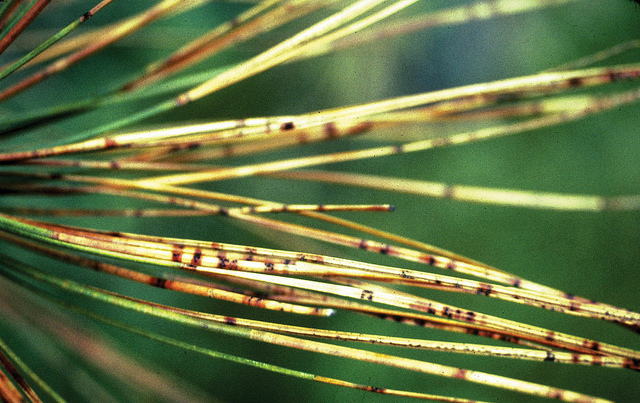This is the fifth part of a series on fall tree diseases and disorders. This article examines black rot of apple and dothistroma needle blight.
Introduction
During fall, the environment undergoes a drastic shift, with cool temperatures prevailing, and inclement weather often abundant. In this climate, many plant diseases flourish. The following describes some of the most common plant diseases to occur in fall, and how they affect their hosts.
Black Rot of Apple (Bostryosphaeria obtusa)
Black rot of apple, also called frogeye leaf spot, is a fungal disease that infects the fruit, leaves, and bark of various hardwood trees, including apple, pear, and quince. The disease is caused by the fungal pathogen Bostryosphaeria obtusa. The fungus is pathogenic on fruit trees. On most other hardwoods, the fungus is a secondary invader, or a saprophyte, colonizing and thriving on dead or weakened tissue. Black rot infections result in the formation of leaf spots and cankers on branches, while also causing fruit to degrade. On infected hosts, loss of fruit yield and extensive defoliation from leaf spot is common. Severe infections can reduce tree vigor, rendering hosts more susceptible to invasion from other disease pathogens and insects.
Hosts
Black rot primarily infects apple, cranberry, pear, and quince. As a secondary invader, black rot may infect alder, apricot, amelopsis, birch, bittersweet, catalpa, chestnut, cotoneaster, currant, dogwood, elder, hawthorn, hophornbean, lilac, linden, maple, mountain ash, mulberry, oak, peach, persimmon, rose, sassafras, sumac, tree of heaven, and witch hazel.
Symptoms of Infection
Initial fruit infections occur during the bloom period. Symptoms of fruit infection will generally become apparent in midsummer, as the fruit matures. Decaying tissue with brown and black concentric rings may be observed on large sections of infected fruit. Some fruit will become desiccated, and remain attached to the tree. Occasionally, fruit will ripen prematurely, with the rotten tissue concentrated at the core.
Leaf infections develop as the bloom period concludes. Infected leaves will develop circular lesions with purplish or reddish outer borders, and light tan interiors. Cankers appear as sunken, reddish brown areas on infected branches and twigs. Cankered sections of the tree will often have rough or cracked bark.
Management
- Prune out and dispose of dead or diseased plant parts on susceptible trees. Administer pruning cuts at least fifteen inches beneath infected tissue. Infected plant parts can be burned, buried, or composted. Pruning should be performed during winter, when the fungus is inactive.
- Control fire blight by excising infected wood from plants.
- Maintain plant vigor by reducing stress from environmental conditions, and limiting insect infestations.
- Ensure that plants are sufficiently watered, especially during extended periods of drought.
- Apply a layer of organic mulch around the base of susceptible plants to improve soil quality, moderate soil temperature, and retain soil moisture.
- Remove the stumps of infected trees that are culled. Dead stumps may serve as overwintering sites for the disease pathogen.
- Fungicidal sprays may be utilized to prevent the infection of leaves and fruit. Initial applications should begin in early spring, during leaf expansion. Thoroughly drench the leaves and fruit to ensure efficacy. Susceptible branches may still be infected by the spores.
Dothistroma Needle Blight (Dothistroma pini)
Dothistroma needle blight, often referred to as red band disease in the western United States, is a devastating foliar disease of pines. The causal agent of the disease is the fungus, Dothistroma pini. The fungus infects, and kills susceptible pine needles. Severe infections can defoliate host trees, hindering their growth, and rendering them prone to failure.
Hosts
Dothistroma needle blight affects twenty nine pine species and hosts. Austrian, lodgepole, and ponderosa pines are the most commonly infected. Scots pine, and mugo are also infected, albeit with less frequency.
Symptoms of Infection
Dark green bands, and yellow to tan spots appear on infected needles. The dark green bands fade as the disease progresses, making them increasingly difficult to detect. The spots and bands later turn brown to reddish-brown. In California, Oregon, Washington, and Idaho, the bands tend to exhibit a brighter shade of red. The black fruiting bodies may be visible on the surface of the infected needles within the spots and bands. The ends of the infected needles become discolored, initially appearing light green before turning tan, and then brown. The base of the infected needles remains green. The needles may develop extensive necrosis two to three weeks after they have been infected. Infected needles are often shed from the tree, with second year needles dropping first. Needles that become infected the year they emerge often remain on the tree until late summer of the following year. Infection is generally most severe in the lower part of the crown. Successive years of infection can culminate in tree mortality.
Management
- Registered fungicides may be utilized to prevent infections. Two applications should be performed during the growing season: one in late spring, to protect the older needles, and a second in early summer to protect the current year’s needles.
- When planting in urban settings, select resistant varieties, such as Mugo and Scots pine. Allow for ample spacing between trees.
- If a tree is planted in a landscape setting that has an irrigation system installed, ensure that they water does not splash onto the needles. Damp foliage is more prone to infection.
- Thin out dense canopies to promote air circulation, and sustain tree vigor.
- Maintain tree vigor through sound cultural practices. Ensure that trees are sufficiently watered, especially during periods of extended drought. Apply a layer of organic mulch around the base of trees to improve soil quality, moderate soil temperature, and retain soil moisture.
Photo courtesy of Department of Agriculture CC-by-2.0
